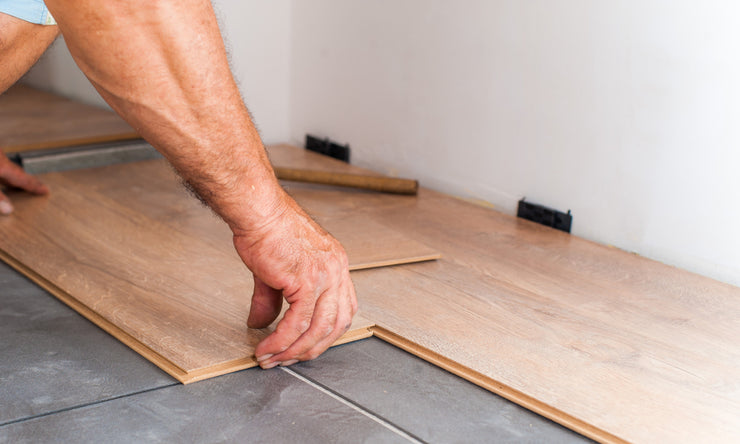
Laying Laminate on Uneven Flooring: How to Fix your Subfloor
Laying laminate on uneven flooring can be a real headache. Not only can it result in a bumpy surface, which can be hazardous and unsightly, but it can damage the quality of your laminate flooring.
If you want to avoid these problems, preparing your subfloor is essential. Today, we’ll go over some tips and tricks on how to fix your subfloor so that you can transform your home without any issues.
Why is a level subfloor important?
A level subfloor is crucial when laying laminate flooring because it ensures it looks and performs its best.
If the subfloor is uneven, the laminate flooring may have gaps that wear it down quicker and lead to damage over time. Laying your laminate on an ill-prepared surface can also cause the flooring to shift or even buckle, leading to an unsafe, unsightly finish.
By ensuring that the subfloor is level before laying the laminate flooring, you can ensure that the final result will look beautiful, be safe to walk on, and last for decades with proper maintenance.
What are the different types of subflooring?
Before we dive into how to fix your subfloor, you should understand the different types you may encounter.
Plywood Subfloor
Plywood subflooring is common in homes with wooden frames: until the 1980s, it was the only type of subfloor available. Several layers of wood veneers are cross-laminated and glued together to create a sturdy base for flooring.
Concrete Subfloor
A concrete subfloor consists of slabs around 4 to 6 inches thick, poured onto a building’s foundation to create a flat, solid surface for flooring. You can find it in residential and commercial buildings, including houses, apartments, office buildings, and retail spaces.
Concrete subflooring is renowned for its long-lasting durability and strength, making them popular for high-traffic areas of a property or home. They can be left bare or covered with various flooring materials, including laminate, tile, or carpet.
How to fix an uneven subfloor
Laying laminate on uneven flooring is a recipe for disaster. That’s why, before the installation, you should use a spirit level to see what you’re dealing with. Rest the bottom edge of the level against your subfloor and check if any bubbles appear.
If you notice that the bubble moves outside of the two horizontal lines, your subfloor is uneven. Repeat in various spots to see which parts of your flooring you’ll have to even out. Then, depending on the subfloor you’re working with, you have several ways to fix it.
1. Self-Levelling Compound
Self-levelling compounds are polymer-modified cement solutions that transform your subfloor from rough to level.
With countless options on the market, you must choose the correct type of compound for your subfloor and follow the manufacturer's specific instructions throughout the application.
After settling on your compound, vacuum your subfloor to get rid of dust and dirt: this will prevent any adhesion difficulties. Cover your skirting boards with masking tape and mix your self-levelling compound into a large bucket with the appropriate amount of water.
Using an electric drill, whisk your mixture until it reaches a consistent texture and colour. Then, pour your mixture onto your subfloor and use a trowel to spread the compound evenly, remembering to include the corners!
Leave your mixture to dry for the recommended time before applying your laminate flooring.
2. Grinding and Sanding
Before you begin, inspect the subfloor for any loose boards or nails. If you find any, repair or replace them before continuing. Then, you should choose the right type of sander for your particular subfloor.
Working in small sections and moving in a back-and-forth motion, sand the subfloor whilst wearing ear protection, eye protection, and a dust mask.
Once you have finished, use a vacuum cleaner to remove all dust and debris from the subfloor. Then, clean the surface with a damp cloth to remove any remaining dust.
3. Use Thick Underlay
A high-quality underlay can smooth out bumps or waves, with countless options to level your subfloor.
Lay the underlayment in one corner of the room, ensuring it is straight and aligned with the edge of the subfloor.
Then, proceed to cut it with a utility knife. If you need more than one piece of underlayment, overlap the seams by 2-3 inches and use tape to secure them together.
Remember to cut around any obstacles, such as pipes or vents, as you continue laying the underlayment along the entire length of the subfloor. Once the underlayment is fully installed, use a utility knife to trim any excess along the room's edges.
Then, you can start laying your laminate floor!
4. Install Plywood
Our final solution involves plywood: install plywood veneers of differing thicknesses to level out any dramatic variations in level. You should use strong, durable nails to secure the plywood if working with a wooden subfloor.
However, if your subfloor is concrete, you must use bolts penetrating the slabs.
Choose Mersey Flooring for Premium Laminate Flooring!
Now that you have successfully fixed your uneven subfloor, it's time to cover it with high-quality laminate flooring. Mersey Flooring offers a diverse selection of laminate flooring perfect for any home renovation project.
Visit our website or showroom to explore our wide range of laminate flooring options, from classic wood designs to modern and herringbone patterns. Our knowledgeable staff is always available to answer any questions and help you choose the perfect flooring for your home.